A Close Look At The New 2023 BMW S1000RR Motorcycle (Video Review Included)
The BMW S1000RR has evolved over the years and compared to it's original "game changing" 2009 descendant, the 2023 version has less than 5% of the 8,200 components that make up the entire motorcycle, including the engine, which was an ultra short-stroke version found in the 2009 BMW S1000RR-which had set new standards for series production four-cylinder Superbike technology in its day. The management of BMW Motorrad wanted to significantly improve the performance of the current bike, which meant making it lighter by more than 10 kg, faster on the racetrack, easier to control, and more maneuverable. In order to achieve this, a brand-new, lighter, more compact, and more powerful 999cc engine measuring an unchanged 80 x 49.7 mm and weighing 8.8 lbs less had to be created. This was made possible in part by rods that were 10% lighter and 4 mm shorter than before and a crankshaft that was 4 lbs lighter than before, which together produced even better pickup throughout the rev range. The application of BMW's patented "ShiftCam" Technology, first seen on that year's R1250GS adventure tourer's Boxer motor, was the most significant advancement that was carried over to the 2023 model in addition to these other features. This technology was later expanded to BMW's four-cylinder lineup. Along with revised cam profiles, this technology combines variable intake valve timing and differential valve lift, resulting in at least 73.8 lb-ft of torque being made available between 5,500 and 14,600 rpm, where the short-stroke engine's unchanged soft-action limiter cuts in. This 8.8-lb weight savings was achieved despite the 2.2-lb weight penalty associated with installing the "ShiftCam" system.
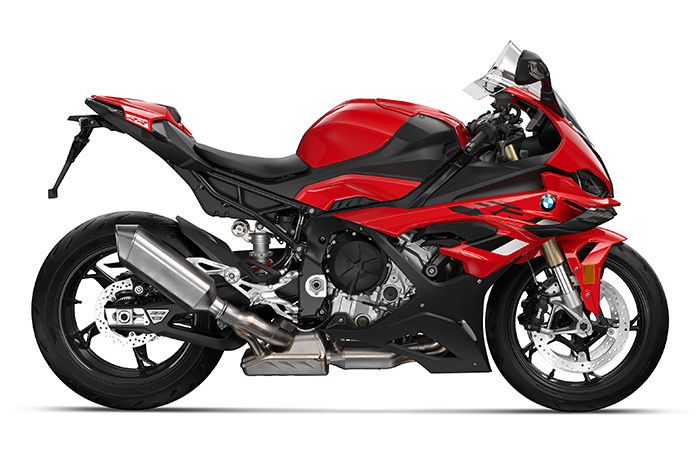
BMW has now transferred the M1000RR's airbox and cylinder head to the mass-produced, Euro 5-compliant 2023 S1000RR, though its new intake porting is cast in here rather than milled out, as on the M RR, in an effort to increase performance at higher revs. The upgraded S RR engine has the same intake system as before, but an electric servomotor mounted on the air box that runs at 11,900 rpm (a significant 2,900 revs higher than before) further lowers the height of the inlet trumpets atop the 48mm throttle bodies, which are now shorter overall for the 2023 model, to improve top end performance in conjunction with the ShiftCam Technology system. BMW has been able to increase power by 3 horsepower to 207 horsepower at 13,750 rpm, 250 revs higher than before, with peak torque remaining constant at 83 lb-ft but delivered at 11,000 rpm.
The 4-throttle butterflies are also operated by a throttle linkage that is divided into two parts, with the two left-hand throttle bodies being operated independently of the two right-hand ones. Because of this, BMW race teams have been able to program the two pairs to operate independently at lower rpm to provide the same advantages as a twin-cylinder motor in terms of traction and drive exiting a turn, before all four resume operating jointly at higher revs. This feature came about as a result of BMW deciding against building a big-bang crossplane-crank engine in the style of the Yamaha R1 and instead using its ten years of experience with a more conventional 180 degree screamer motor to create a better such design. BMW has acknowledged that at the very beginning of the 2019 redesign development program, they did consider briefly creating a V4 engine. However, they decided against both of these early on because they didn't want to be perceived as copying anyone else and also because they had so much experience developing the more conventional type of four-cylinder in-line engine—especially from Superbike and Endurance racing—that they decided to focus on creating an even better one.
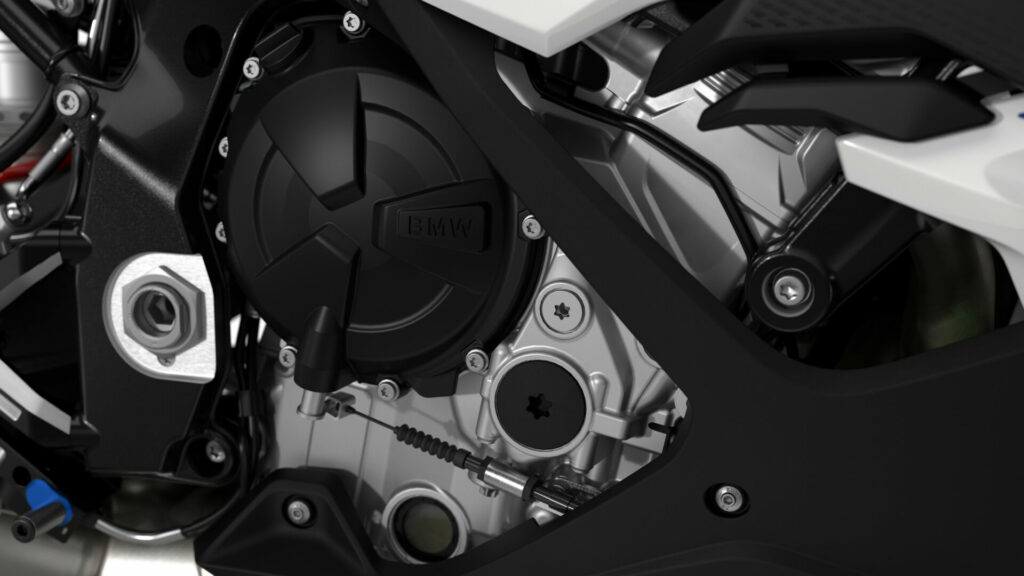
The 2023 S1000RR's transmission gearing has been lowered via a 1T larger rear sprocket, which is up from 45T to 46T, complementing the added performance higher up the rev range. This allows you to increase the revs faster to access the extra power and the larger spread of torque. All of this is done to increase acceleration and improve rear end grip, albeit at the expense of a slight drop in top speed from 190 mph to 188 mph.
The most obvious distinction between the new and old can be seen in the winglets attached to the subtly altered bodywork of the 2023 S1000RR, which are also derived from the M-series model. These are not just for show; it is claimed that they can produce up to 16.8 lbs of down-force at 124 mph and up to 37.7 lbs at 186 mph. On a machine with such a slinky appearance as the '23 S1000RR, their appearance might not be to everyone's taste, but in this class of motorcycle, function always comes first. At the expense of less torque and power being transmitted to the rear tire, they assist in reducing wheelies without TC being required to do so. This translates to better acceleration and better cornering and braking traction from the front tires. Although the winglets inevitability increase drag, the additional power of the engine more than makes up for it. In addition, BMW has improved the flow around the rider's helmet with a taller, reshaped windshield, and there has been an additional aerodynamic improvement made by separating the lower triple clamp.
The bodywork is available in 3 colors: Black metallic, Red non-metallic, and BMW's iconic white. All 3 variations are priced at $17,895, as opposed to the M1000RR's $32,495 price in 2022.
This shark-eyed bodywork surrounds an updated version of the RR's current aluminum bridge frame, which has new front and rear sections and a shorter number plate holder. This entails a welded-up assembly of four distinct gravity die-cast elements that surround the engine and serve as a fully load-bearing chassis component. The engine is still angled forward by 32 degrees as before. However, the so-called "Flex Frame" has now been given several cutouts in its flanks to promote flex with the intention of optimizing lateral flex in order to give the rider more feedback on what the wheels are doing. This tactic first appeared outside of Japan in the Rumi Honda RC30 raced in the 1990 World Superbike series by Baldassarre Monti. It dates back to the works of Honda RVF750 Suzuki Endurance racers of the '80s. The 2023 S1000RR is the latest such bike to gain from this tactic. This was the first aluminum framed Superbike to explore this technique of promoting flex in pursuit of the same rider-friendly "talkback" that Ducati V-twin riders have always savored with their tubular steel chassis.
In addition, the steering of the new RR chassis is less aggressive than that of the M RR, with the steering head angle for the fully-adjustable 45mm closed-cartridge Marzocchi fork that delivers 4.7 in. of wheel travel being kicked out by 0.5 degrees to 23.6° and the offset being lowered by 3mm, resulting in a trail increase from 3.7 in. to 3.9 in. A brand-new gravity diecast one-piece twin-sided swingarm with underslung sections has been used to increase the wheelbase, which is now 57.4 inches (up from 56.7 inches, or three-quarters of an inch longer). The rear wheel is easier to install and remove because the brake pads and anchor plate have been chambered, and the right side rear axle bushes have been mounted differently to prevent loss. The swing-arm pivot point's are adjustable and the height of the rear Marzocchi shock, both of which are fully ten-click adjustable and provide 4.6 inches of rear axle travel, are both transplants from the M RR. The optional DDC (Dynamic Damping Control) package, which provides semi-active electronic damping adjustment front and rear, was installed on my test bike. The settings of this package are adjusted to match the chosen riding mode.
A Ride by Wire (RBW) throttle on the 2023 S1000RR offers five different riding modes which are: Road, Rain, Dynamic, and Race Pro-which also has three levels of throttle response and engine braking options. Combining these with a triple-axis, six-direction Continental IMU allows them to control a variety of rider aids, the majority of which are switchable: cornering ABS Pro, multi-stage DTC, engine braking adjustment, anti-wheelie, hill start assistance, launch control, cruise control, a lap timer, three-stage heated grips, a pit lane speed limiter, engine braking torque control (MSR), and the Dynamic Brake Control (DBC).
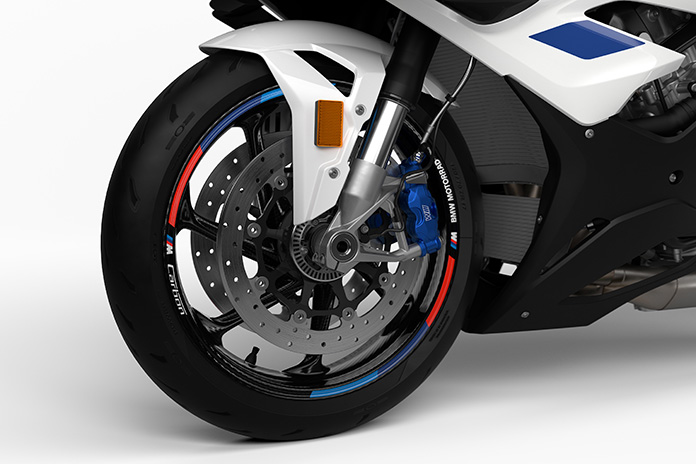
The Brake Slide Assist (BSA) system, which BMW is particularly proud of, allows you to back into a turn if you are sufficiently experienced and brave to do so. It does this by limiting rear wheel spin and rear brake pressure in order to achieve a controlled, predetermined drift angle, before the lean-sensitive ABS cuts in. This new system, which is based on steering angle sensors mounted for the first time on the bike, enables you to set a particular drift angle for maneuvers known as braking drifts while entering turns at a constant speed. When the desired steering angle is reached, TC steps in to stabilize the bike and reduce spin.
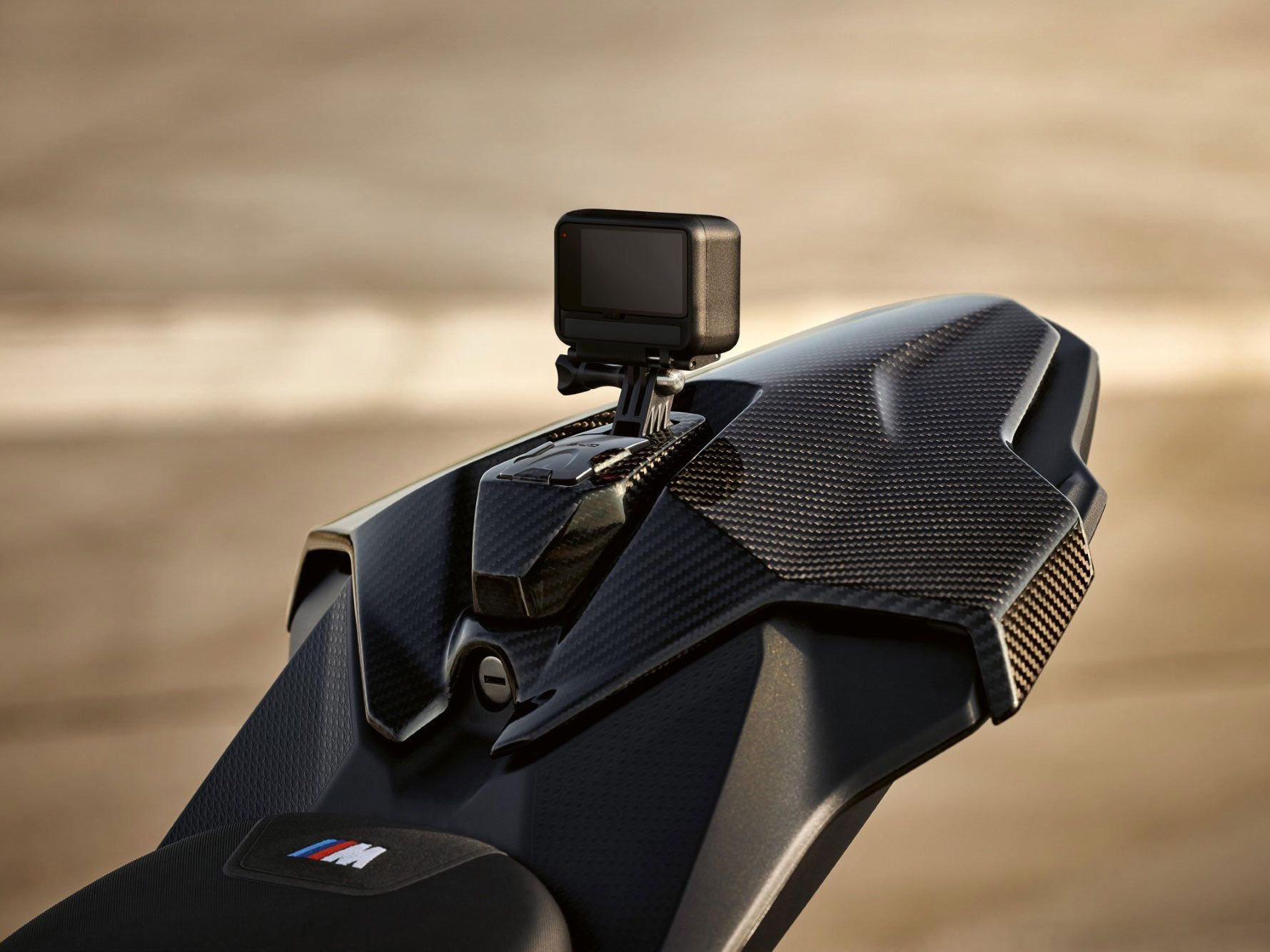
A small battery, a USB port, a very cool GoPro holder, and a new wiring cover are also included. The latter makes it simpler to remove the rear lights and license plate holder. The new bike's curb weight is still 434 pounds with all liquids and a full 4.4 gallon gas tank (or about 392 pounds dry); 431 pounds with the Race Package option, which substitutes forged aluminum wheels for the stock cast ones; and 426 pounds with the M Package option, which includes the carbon wheels and seat installed on the test bike. Additionally, it included the Performance Package, which included the Endurance chain created by BMW's factory World Endurance team and an Akrapovic slip-on exhaust. The same twin 320mm Brembo front discs that were previously used to stop the overall effect are now gripped by new Nissin monoblock four-piston calipers, which have taken the place of the startling Hayes stoppers that were introduced in 2019 as a replacement for the Brembos that were previously used. The rear disc measures 220 mm and has a twin-pot caliper. The necessary upgrades have been made to Continental's cornering ABS.
Despite the in-line four configuration of the motor, BMW claims that the frame is surprisingly narrow, being only 20mm wider than a V4 engined bike of equivalent capacity at the stepover point behind the fuel tank. This gives you space to move around the bike as needed and makes it easier for you to grasp the fuel tank, which is made of three welded-together aluminum sections.
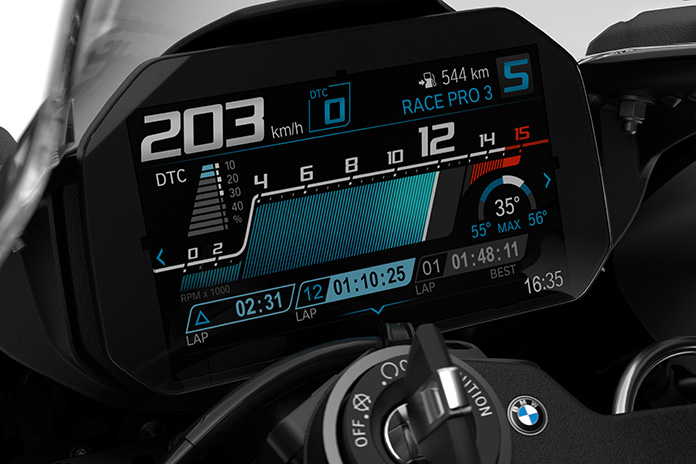
In addition to the taller, reshaped new screen, which helps you feel like you're sitting inside the BMW rather than on top of it, the clip-on bars are spread further apart than on the previous bike, contributing to the same improbable sense of spaciousness for what in the metal is a much smaller bike than it appears in photos. It also provides excellent protection for a rider standing 5'10" down Almeria's main straight, with the digital speedometer on the 612in. TFT dash reading just above 170 mph. Compared to the older bike, there doesn't seem to be as much weight on your wrists and shoulders, so this new one should be even more comfortable to ride for the longer distance.
When you get overly ambitious with your turn speed and have to back off the throttle entering a bend at the risk of missing your apex and drifting wide, you think the BMW's electronics take over and close the corner entry for you, so that you're back where you should have been in the first place, but for your excess of confidence. This is a bike that is easier than ever to go fast on, but will also pardon your inevitable overconfidence mistakes in a way that's almost uncanny- As I said, strange. The same thing happens when you brake from a speed of about 170 mph at the end of the main straight, which is half a mile long, into a second-gear 90° right-hander. When you max out your late-braking abilities, the engine braking program delivers total stability, which not only gives the impression that you could have hit the incredibly effective Nissin/Brembo brake mix a little bit later on each lap, but also allows you to recover, stop, turn in, and continue as usual with hardly any time lost when you inadvertently go past your turn-in point.
The overwhelming impression you get while riding this new BMW is how simple it is to do so in a manner that approaches anger, which seems utterly improbable to say of a 200bhp-plus motorcycle. When you wind the throttle wide open and click through the gears on the wide open two way quickshifter, the ShiftCam function, the sticky dual-compound Bridgestone rear slick, the lean-sensitive Continental TC, and that shorter overall gearing combine with the engine's accessible power delivery even in Race Pro mode to deliver truly thrilling acceleration. However, you don't even need to touch the rear brake lever with your right toe to stop a time-wasting delay.
Similarly, the 396-lb motorcycle's improbably delicate, precise steering helps you navigate that triple-axis turn while you play with the throttle to find the right speed for each section of the bend. Any rider will know that in order to solve that dynamic puzzle correctly and repeating it lap after lap brings enormous satisfaction. This BMW will play a crucial role in assisting you in achieving that. Once you have finally rediscovered the right line and dialed in the proper cornering speed. What a pleasure it is to ride hard on a bike with such responsive, well-mapped fueling that allows you to gradually open the throttle as the turn you are taking opens up, feeling the rear Bridgestone hook up beneath you. Even riders who are relatively inexperienced with this level of performance will discover that this bike fosters confidence as they gradually learn how to use the 200+ horsepower engine power that is delivered to them with no sense of intimidation.
The new 2023 S1000RR has a level of performance and a degree of electronic support that puts it on a whole new level compared to its 2019 predecessor, the last time that BMW reinvented its Superbike model. This is due to having more power, updated electronics, stronger brakes, a more responsive, more flexible chassis with revised geometry that talks right back to you, and winglets straight from the MotoGP paddock. With this new BMW, it's simple to travel at a rate that each of us would deem to be swift by our own personal standards. It is an enormously capable superbike for riders of all skill levels, from graduates of the 600/765/950 Supersport to seasoned Superbike racing professionals, but with an even larger safety margin built in.
(video credits: Bennetts BikeSocial)
Specs: 2023 BMW S1000 RR
| Engine | Liquid-cooled inline 4-cylinder |
| Capacity | 999cc |
| Bore x stroke | 80.0 mm x 49.7 mm |
| Power | 207 hp at 13,750 rpm (claimed) |
| Torque | 83 lb-ft. at 11,000 rpm (claimed) |
| Max. engine speed | 14,600 rpm |
| Compression ratio | |
| Fuel | Power rated at 98 RON. 95-98 RON knock control |
| Valvetrain | DOHC, valve actuation via single cam followers, BMW ShiftCam variable intake cam control |
| Valves per cylinder | |
| Intake / Exhaust valve diameter | 33.5 mm / 27.2 mm |
| Throttle body diameter | 48 mm |
| Engine control | BMS-0 |
| Emission control | Closed-loop three-way catalytic converter |
| Alternator | 493 watts |
| Battery | M lightweight battery 12v / 5 Ah |
| Headlamp | LED free-form twin low-beam, LED free-form high-beam |
| Starter | |
| Clutch | Self-reinforcing multi-plate anti-hopping oil bath clutch, mechanically operated |
| Gearbox | 6-speed, constant-mesh |
| Secondary ratio | |
| Rear wheel drive type | Chain |
| Frame construction type | Aluminum composite bridge frame, engine self-supporting |
| Front suspension | Upside-down telescopic fork, slide tube diameter 45 mm, spring preload, compression and rebound stage adjustable, DDC option: damping electronically adjustable |
| Rear suspension | Aluminum underslung double-sided swingingarm with central spring strut, spring preload, adjustable compression and rebound stage ,DDC option: damping electronically adjustable |
| Suspension travel front / rear | |
| Wheel castor | |
| Steering head angle | |
| Brakes, front | Twin M 320 mm / 12.6-inch floating disks; 4-piston fixed calipers |
| Brakes, rear | Single 220 mm / 8.7-inch, two-piston fixed caliper |
| ABS | BMW Motorrad ABS Pro, partially integral, disengageable |
| Traction control | BMW Motorrad DTC |
| Wheels | Standard: Die-castaluminum wheels M aluminum-forged wheels as part of Race Package option M Carbon wheels as part of M Package option |
| Wheels, front / rear | |
| Tires, front / rear | 120/70 ZR17 / 200/55 ZR17 |
| Length | 81.6 inches |
| Width | 33.3 inches |
| Wheelbase | 57.4 inches |
| Seat height | 32.4 inches |
| Curb weight | Standard: 434 pounds (claimed) Race: 431 pounds (claimed) M: 427 pounds (claimed) |
| Fuel tank capacity | 4.36 gallons |
Recent Posts
-
How to Decode the Many Harley Davidson Acronyms, Models, Codes, & Styles
Harley Davidson has A LOT of models, acronyms, and different style bikes which can lead to plenty of
-
Have You Seen the Limited Edition 2023 Jack Daniel's Indian Chief Bobber Dark Horse? -Check Out the Full Review with video included
Since 2018, Jack Daniel's and Indian Motorcycle have developed a successful partnership together. Wi



